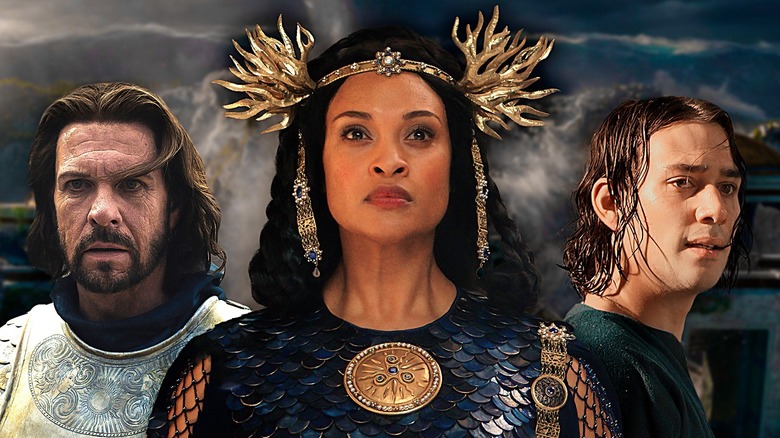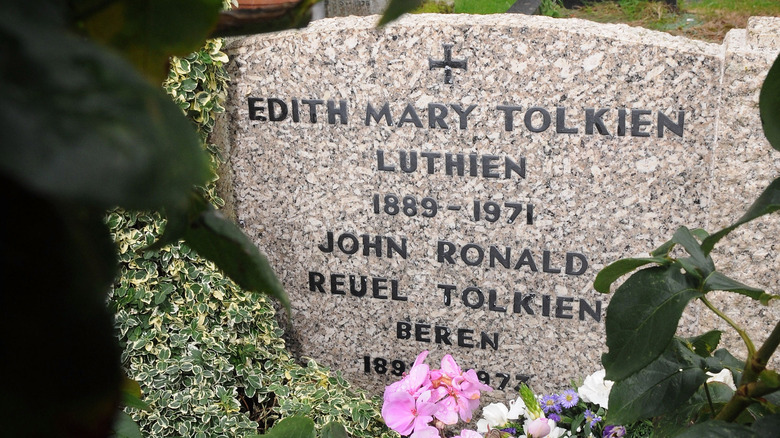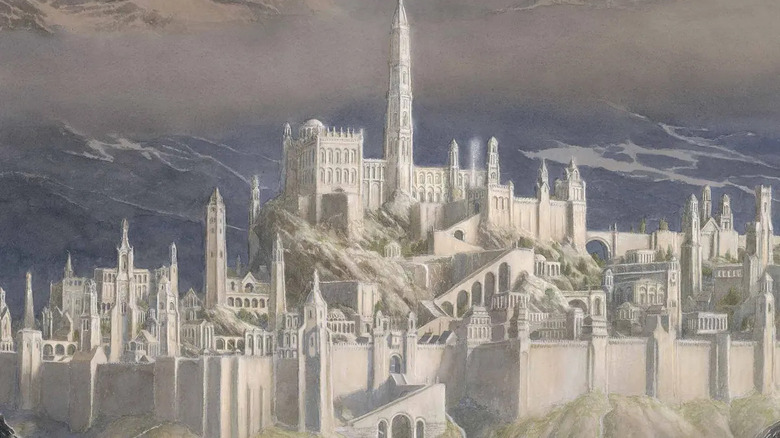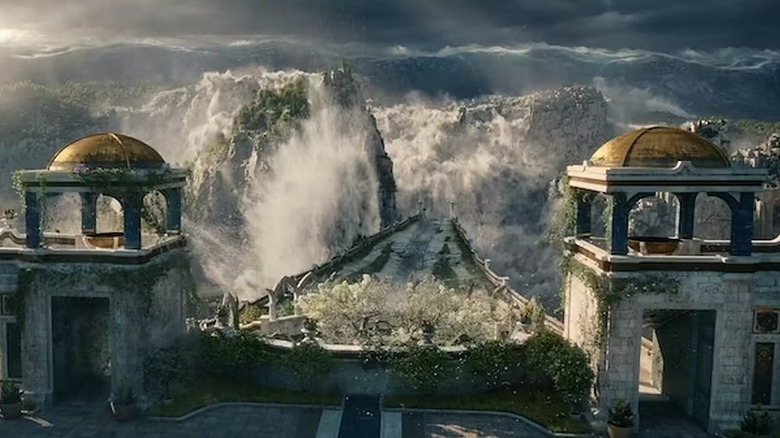Lord Of The Rings: 5 Stories Every Real Fan Must Know
J.R.R. Tolkien is famous for building the intricate and complex world of Middle-earth. The Oxford professor approached each character, nation, place, and event with a deep sense of care, as if he wasn't creating something from scratch so much as reporting what he had really observed. This led to a vast panoply of tales that the author either fully or partially developed that stretches far beyond "The Lord of the Rings" and "The Hobbit" stories that mainstream audiences are so familiar with.
Tolkien's son, Christopher, polished up and published many of these narratives after his father's death, including now-famous novels such as "The Silmarillion," "Unfinished Tales," and the massive, multi-volume History of Middle Earth compendium. While these are packed with countless accounts and fascinating details that span Middle-earth history, some stories stand out more than others.
These are the major epics that even those mildly obsessed with Middle-earth are well aware of and which any true Tolkien aficionado knows in intimate detail. We're talking about things like the destruction of the Two Trees of Valinor. The account of Aragorn's pre-"Lord of the Rings" exploits is also a well-known chapter of supplemental Tolkienian lore, as is the War of the Dwarves and Orcs, the climax of which is depicted in flashbacks in Peter Jackson's "The Hobbit" trilogy. While there is enough information available to sate even the most avid readers, there are many major moments like these that qualify as absolute must-reads for anyone who claims to be a real Tolkien fan. Here are five of the most top-tier, deep-cut Middle-earth tales to rule them all.
The Ainulindalë: Tolkien's creation myth
It's no secret that Tolkien was a devout Catholic, and while organized religion rarely features in his tales, the author still honored his monotheistic beliefs within his imaginary world. Tolkien created a clear spiritual hierarchy, with a single Creator, Ilúvatar, sitting at the top of his other-worldly org chart. Below this almighty individual are the Ainur, audible angelic beings who literally sing history into existence through both their own individual agency and Ilúvatar's guidance.
This melodious event is called the Ainulindalë or "the Music of the Ainur," and it is Tolkien's great creation story. While it has echoes of the Genesis story of Christianity, Tolkien makes it a uniquely Middle-earth event. (In the Foreword to "The Fellowship of the Ring," he states, "I cordially dislike allegory in all its manifestations," adding that he prefers a historical delivery — even if it's a fake one — as it allows the reader to interpret, rather than the author to dominate, the narrative.)
In the Ainulindalë, the creation song of the world is interrupted by the Ainu Melkor (later called Morgoth), who sows disruption into the melody. In the end, Ilúvatar weaves even the discordant notes into the greater whole, turning everything into an unstoppable song of deep, irrepressible beauty. When it ends, he shows the Ainur the story that they've sung, and some of them descend into the physical world he's created. These beings become the Valar and Maiar (greater and lesser spirits) who play a major role in Middle-earth history, especially early on in the story. They shape the earth, come up with the illuminating Two Trees, fashion the sun and moon, create the Dwarves, and directly interact with countless Elves, Men, and Orcs. But it starts with that all-encompassing song "in the beginning."
The romantic tale Beren and Lúthien
There are several key stories that drive Tolkien's historical fantasy narrative. The life and family of the human hero Hurin are one of them. The descendants of his brother, Huor, are also critical to the story — his grandson even makes the top-five stories list all on his own. However, if there's one grand tale that takes the cake for Tolkien's most famous and beloved story, it has to be that of Beren and Lúthien.
Beren is a royal human whose kingdom is destroyed in the destructive wars of the First Age, thousands of years before "The Lord of the Rings" takes place. While living as an outlaw, hunted by his enemy, Beren stumbles into the Elvish kingdom of Doriath, where he accidentally runs into the superpowered Lúthien Tinúviel, the half-Elvish, half-Ainur princess of the land. The two fall in love, but Lúthien's father won't allow his daughter to marry the dispossessed mortal, cheekily adding that Beren can only win his daughter's hand if he steals one of the hallowed jewels called the Silmarils. The only issue? They're located on the iron crown of Morgoth.
This leads to an epic tale where first Beren and then Lúthien, too, set off to fulfill the outrageous request. The starstruck lovers are aided by the talking hound Huan, fight Sauron, are attacked by wayward Elven lords, and ultimately pass directly into Morgoth's fortress of Angband itself, where they do indeed steal a silmaril. The barn burner of a narrative goes on into tragedy, death, and resurrection. The Beren and Lúthien story is especially important because Tolkien personally identified with it. He considered himself the lowly, desperately romantic Beren, and his wife, Edith, was his Lúthien. They even marked their gravestones with the names.
It all started with the Fall of Gondolin
The destruction of the city of Gondolin marks one of the final chapters in the First Age of Middle-earth history. In other words, when the hidden Elvish city is destroyed in "The Silmarillion," it's part of a cascading event of defeats that nearly leads the Dark Lord Morgoth to complete victory (and subsequently pushes his greatest enemies to finally overthrow him). But while it is a climactic event in the early stories of Middle-earth, Gondolin, and more specifically, the fall of Gondolin, actually has the unique honor of being the first ever Middle-earth story that Tolkien wrote. He composed the initial version way back in 1917, when he was on sick leave during World War I. This was nearly forty years before "The Lord of the Rings" was published, and it served as the story germ from which the rest of Tolkien's world grew.
The event itself tells of the final days of the great fortress city of Gondolin. Founded by the Elven leader Turgon as a secret fastness designed to defy the growing power of Morgoth, the city is betrayed and burned to the ground. However, in that process, there are epic duels and heroic last stands. Critically, a group of survivors escapes, including the Human Tuor, his wife, the Elven princess Idril, and their half-elven son Eärendil. This sets the stage for another of the great stories of Tolkien's legendarium — the heroic voyage Eärendil and his wife embark upon to save Middle-earth from complete domination by Morgoth.
Eärendil is a mariner who saves the world
Early in Elvish history, many of the immortal folk went over the seas into the West. There, the spiritual guardians of the world, called the Valar, keep them safe from the Dark Lord Morgoth's minions. When Morgoth destroys the Two Trees and steals the Silmarils, the Elves' most precious worldly possessions, many Elves return to Middle-earth to fight him. However, in doing so, they defy the Valar and are banned from the West.
This sets the stage for the First Age of Middle-earth history, during which many of the stories on this list occur. Beren and Lúthien's tale takes place at this time, as does the Fall of Gondolin. Eventually, it becomes clear that Morgoth is simply too strong for the banned Elves and their Human allies to stop on their own. The exiles are conquered one by one until there is no hope of their defeating their universal foe — at least, not on their own.
Some Elves try to sail west to ask for help, but none of them manage to do so successfully. Finally, the half-elven, half-human Eärendil steps up and offers his services as a sailor. Eärendil's ancestors come from both the great houses of Men and Elves, and through his bloodline, he has a unique claim to represent all of those resisting the Dark Lord. (He's also the father of Elrond and Elros, which is pretty neat.)
Eärendil builds the mighty ship Vingilot, and, with the help of his wife, Elwing, and the Silmaril that she brings him, he sails west, reaching the Blessed Realm and requesting aid from the Valar. This saves Elves, Men, and Dwarves from destruction and directly leads to the downfall of Morgoth (and the subsequent rise of Sauron).
The Atlantian epic of the Akallabeth
While most of the bigger stories on this list take place in or before the First Age, this last one jumps to the later days of the Second Age, just a few thousand years before "The Lord of the Rings." The Akallabeth, or "The Downfall of Númenor," tells the tale of the mighty men of the nation of Númenor, who are gifted their island nation following Morgoth's downfall at the end of the First Age. Over the next few millennia, the Númenóreans build a powerful maritime nation. However, they also become prideful and start to tussle with Sauron, who has become the new top dog on the mainland of Middle-earth.
When the Númenórean king Ar-Pharazôn confronts Sauron, the Dark Lord surrenders willingly and is brought back to the island fortress of his enemies as a prisoner. Eventually, he gains the ear of the king and is not only released from prison but made a royal counselor. He poisons the king's mind and convinces him to revolt against the Valar in the West. When Ar-Pharazôn leads an armada to attack, the Creator, Ilúvatar, steps in, sinking the armada and the entire island, to boot. Only a handful of survivors escape the catastrophe on ships, led by the faithful heroes Elendil and his sons Anarion and Isildur. They head to the mainland and create new kingdoms, including Gondor, which begin fighting Sauron all over again before long.
The Akallabeth is one of Tolkien's great tragic tales. It is also one of the central stories of Amazon Studios' "The Rings of Power" series and will doubtless feature heavily in the later stages of the five-season story.





